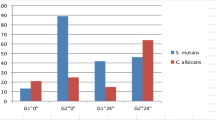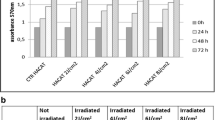Abstract
Candida spp. usually colonize ulcerative lesions of atrophic mucosa in patients with chemotherapy-induced oral mucositis inducing severe inflammation. The spread of antifungal-resistant strains strongly encouraged the search of complementary or alternative therapeutic strategies to cure inflamed mucosa. In this paper, we studied the effects of a near-infrared (NIR) laser system with dual-wavelength emission (808 nm + 904 nm) on the survival and inflammatory potential of C. albicans, C. glabrata, and C. parapsilosis. Laser treatment was performed with a Multiwave Locked System laser. Survival and apoptosis of fungal strains were evaluated by colony-forming units (CFU) counting and annexin V staining. Cytokine production was evaluated by ImmunoPlex array. Laser treatment significantly affected the survival of Candida spp. by inducing apoptosis and induced a lower production of inflammatory cytokines by dendritic cells compared to untreated fungi. No differences in the survival and inflammatory potential were recorded in treated or untreated Saccharomyces cerevisiae cells, used as the control non-pathogenic microorganism. Laser treatment altered the survival and inflammatory potential of pathogenic Candida spp. These data provide experimental support to the use of NIR laser radiation as a co-adjuvant of antifungal therapy in patients with oral mucositis (OM) complicated by Candida infections.




Similar content being viewed by others
References
Lalla RV, Saunders DP, Peterson DE (2014) Chemotherapy or radiation-induced oral mucositis. Dent Clin North Am 58:341–349
Rautemaa R, Ramage G (2011) Oral candidosis—clinical challenges of a biofilm disease. Crit Rev Microbiol 37:328–336
Pfaller MA, Diekema DJ (2007) Epidemiology of invasive candidiasis: a persistent public health problem. Clin Microbiol Rev 20:133–163
Lalla RV, Patton LL, Dongari-Bagtzoglou A (2013) Oral candidiasis: pathogenesis, clinical presentation, diagnosis and treatment strategies. J Calif Dent Assoc 41:263–268
Gobbo M, Ottaviani G, Perinetti G, Ciriello F, Beorchia A, Giacca M, Di Lenarda R, Rupel K, Tirelli G, Zacchigna S, Biasotto M (2014) Evaluation of nutritional status in head and neck radio-treated patients affected by oral mucositis: efficacy of class IV laser therapy. Support Care Cancer 22:1851–1856
Maver-Biscanin M, Mravak-Stipetic M, Jerolimov V (2005) Effect of low-level laser therapy on Candida albicans growth in patients with denture stomatitis. Photomed Laser Surg 23:328–332
Basso FG, Oliveira CF, Fontana A, Kurachi C, Bagnato VS, Spolidório DM, Hebling J, de Souza Costa CA (2011) In vitro effect of low-level laser therapy on typical oral microbial biofilms. Braz Dent J 22:502–510
Souza RC, Junqueira JC, Rossoni RD, Pereira CA, Munin E, Jorge AO (2010) Comparison of the photodynamic fungicidal efficacy of methylene blue, toluidine blue, malachite green and low-power laser irradiation alone against Candida albicans. Lasers Med Sci 25:385–389
Bornstein E, Hermans W, Gridley S, Manni J (2009) Near-infrared photoinactivation of bacteria and fungi at physiologic temperatures. Photochem Photobiol 85:1364–1374
Chermetz M, Gobbo M, Ronfani L, Ottaviani G, Zanazzo GA, Verzegnassi F, Treister NS, Di Lenarda R, Biasotto M, Zacchigna S (2014) Class IV laser therapy as treatment for chemotherapy-induced oral mucositis in onco-haematological paediatric patients: a prospective study. Int J Paediatr Dent 24:441–449
Collins CD, Cookinham S, Smith J (2011) Management of oropharyngeal candidiasis with localized oral miconazole therapy: efficacy, safety, and patient acceptability. Patient Prefer Adherence 5:369–374
Monici M, Cialdai F, Ranaldi F, Paoli P, Boscaro F, Moneti G, Caselli A (2013) Effect of IR laser on myoblasts: a proteomic study. Mol Biosyst 9:1147–1161
Clemente AM, Fadigati G, Caporale R, Marchese DG, Castronovo G, Sannella AR, Severini C, Verra F, Garaci E, Cozzolino F, Torcia MG (2013) Modulation of the immune and inflammatory responses by Plasmodium falciparum schizont extracts: role of myeloid dendritic cells in effector and regulatory functions of CD4+ lymphocytes. Infect Immun 81:1842–1851
Brachmann CB, Davies A, Cost GJ, Caputo E, Li J, Hieter P, Boeke JD (1998) Designer deletion strains derived from Saccharomyces cerevisiae S288C: a useful set of strains and plasmids for PCR-mediated gene disruption and other applications. Yeast 14:115–132
Rizzetto L, Kuka M, De Filippo C, Cambi A, Netea MG, Beltrame L, Napolitani G, Torcia MG, D’Oro U, Cavalieri D (2010) Differential IL-17 production and mannan recognition contribute to fungal pathogenicity and commensalism. J Immunol 184:4258–4268
Netea MG, Sutmuller R, Hermann C, Van der Graaf CAA, Van der Meer JWM, van Krieken JH, Hartung T, Adema G, Kullberg BJ (2004) Toll-like receptor 2 suppresses immunity against Candida albicans through induction of IL-10 and regulatory T cells. J Immunol 172:3712–3718
Da Silva Dantas A, Day A, Ikeh M, Kos I, Achan B, Quinn J (2015) Oxidative stress responses in the human fungal pathogen, Candida albicans. Biomolecules 5:142–165
Ikner A, Shiozaki K (2005) Yeast signaling pathways in the oxidative stress response. Mutat Res 569:13–27
Brown AJ, Budge S, Kaloriti D, Tillmann A, Jacobsen MD, Yin Z, Ene IV, Bohovych I, Sandai D, Kastora S, Potrykus J, Ballou ER, Childers DS, Shahana S, Leach MD (2014) Stress adaptation in a pathogenic fungus. J Exp Biol 217:144–155
Beaussart A, Alsteens D, El-Kirat-Chatel S, Lipke PN, Kucharíková S, Van Dijck P, Dufrêne YF (2012) Single-molecule imaging and functional analysis of Als adhesins and mannans during Candida albicans morphogenesis. ACS Nano 6:10950–10964
Cheng SC, van de Veerdonk FL, Lenardon M, Stoffels M, Plantinga T, Smeekens S, Rizzetto L, Mukaremera L, Preechasuth K, Cavalieri D, Kanneganti TD, van der Meer JW, Kullberg BJ, Joosten LA, Gow NA, Netea MG (2011) The dectin-1/inflammasome pathway is responsible for the induction of protective T-helper 17 responses that discriminate between yeasts and hyphae of Candida albicans. J Leukoc Biol 90:357–366
Doğan MD, Ataoğlu H, Ataoğlu O, Akarsu ES (1999) Polysaccharide mannan components of Candida albicans and Saccharomyces cerevisiae cell wall produce fever by intracerebroventricular injection in rats. Brain Res Bull 48:509–512
Cheng SC, Joosten LA, Kullberg BJ, Netea MG (2012) Interplay between Candida albicans and the mammalian innate host defense. Infect Immun 80:1304–1313
Mille C, Bobrowicz P, Trinel PA, Li H, Maes E, Guerardel Y, Fradin C, Martínez-Esparza M, Davidson RC, Janbon G, Poulain D, Wildt S (2008) Identification of a new family of genes involved in beta-1,2-mannosylation of glycans in Pichia pastoris and Candida albicans. J Biol Chem 283:9724–9736
Ueno K, Okawara A, Yamagoe S, Naka T, Umeyama T, Utena-Abe Y, Tarumoto N, Niimi M, Ohno H, Doe M, Fujiwara N, Kinjo Y, Miyazaki Y (2013) The mannan of Candida albicans lacking beta-1,2-linked oligomannosides increases the production of inflammatory cytokines by dendritic cells. Med Mycol 51:385–395
Santamaría R, Rizzetto L, Bromley M, Zelante T, Lee W, Cavalieri D, Romani L, Miller B, Gut I, Santos M, Pierre P, Bowyer P, Kapushesky M (2011) Systems biology of infectious diseases: a focus on fungal infections. Immunobiology 216:1212–1227
Carvalho RL, Alcântara PS, Kamamoto F, Cressoni MD, Casarotto RA (2010) Effects of low-level laser therapy on pain and scar formation after inguinal herniation surgery: a randomized controlled single-blind study. Photomed Laser Surg 28:417–422
Güngörmüş M, Akyol U (2009) The effect of gallium–aluminum–arsenide 808-nm low-level laser therapy on healing of skin incisions made using a diode laser. Photomed Laser Surg 27:895–899
Silveira PC, Silva LA, Fraga DB, Freitas TP, Streck EL, Pinho R (2009) Evaluation of mitochondrial respiratory chain activity in muscle healing by low-level laser therapy. J Photochem Photobiol B 95:89–92
Imamura R, Wang Y, Kinoshita T, Suzuki M, Noda T, Sagara J, Taniguchi S, Okamoto H, Suda T (2010) Anti-inflammatory activity of PYNOD and its mechanism in humans and mice. J Immunol 184:5874–5884
Wang Y, Hasegawa M, Imamura R, Kinoshita T, Kondo C, Konaka K, Suda T (2004) PYNOD, a novel Apaf-1/CED4-like protein is an inhibitor of ASC and caspase-1. Int Immunol 16:777–786
Acknowledgments
We thank Prof. G. Mancuso, University of Messina for the generous gift of HEK-293-hTLR4/CD14/MD2 and HEK-293-hTLR2 cells.
This work was supported by grants from the Italian Ministry of Education. Ann Maria Clemente was supported by a grant from Istituto Toscano Tumori.
Conflict of interest
The authors declare no conflict of interest.
Author information
Authors and Affiliations
Corresponding author
Additional information
A. M. Clemente and L. Rizzetto contributed equally to this work.
Rights and permissions
About this article
Cite this article
Clemente, A.M., Rizzetto, L., Castronovo, G. et al. Effects of near-infrared laser radiation on the survival and inflammatory potential of Candida spp. involved in the pathogenesis of chemotherapy-induced oral mucositis. Eur J Clin Microbiol Infect Dis 34, 1999–2007 (2015). https://doi.org/10.1007/s10096-015-2443-5
Received:
Accepted:
Published:
Issue Date:
DOI: https://doi.org/10.1007/s10096-015-2443-5




